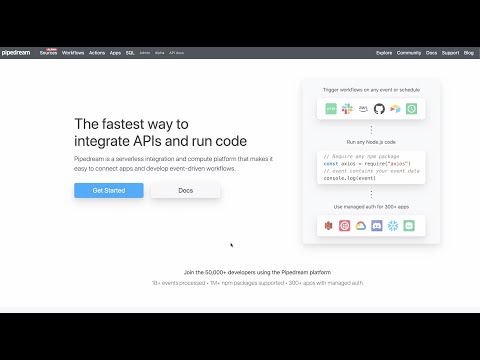What do you want to automate
with Datadog and PagerDuty?
Prompt, edit and deploy AI agents that connect to Datadog, PagerDuty and 2,800+ other apps in seconds.
Trusted by 1,000,000+ developers from startups to Fortune 500 companies
Popular Ways to Connect Datadog with PagerDuty#
Popular Datadog and PagerDuty Triggers#
Popular Datadog and PagerDuty Actions#
Find the user on call for a specific schedule. See the docs here
Overview of Datadog#
The Datadog API, accessible through Pipedream, empowers you to programmatically interact with Datadog's monitoring and analytics platform. This enables developers to automate the retrieval of monitoring data, manage alert configurations, and synchronize service health information across systems. With Pipedream's serverless execution model, you can create intricate workflows that react to Datadog events or metrics, manipulate the data, and pass it on to other services or even Datadog itself for a cohesive operational ecosystem.
Connect Datadog#
import { axios } from "@pipedream/platform"
export default defineComponent({
props: {
datadog: {
type: "app",
app: "datadog",
}
},
async run({steps, $}) {
return await axios($, {
url: `https://api.datadoghq.com/api/v1/user`,
headers: {
"DD-API-KEY": `${this.datadog.$auth.api_key}`,
"DD-APPLICATION-KEY": `${this.datadog.$auth.application_key}`,
},
})
},
})
Overview of PagerDuty#
The PagerDuty API offers a powerful interface to automate your digital operations management. By leveraging its capabilities on Pipedream, you can create workflows that respond to incidents, automate alerts, and synchronize incident data across various platforms. PagerDuty's API enables you to manage services, teams, and incidents, ensuring that your systems remain operational and that the right people are notified at the right time.
Connect PagerDuty#
import { axios } from "@pipedream/platform"
export default defineComponent({
props: {
pagerduty: {
type: "app",
app: "pagerduty",
}
},
async run({steps, $}) {
return await axios($, {
url: `https://api.pagerduty.com/users/me`,
headers: {
Authorization: `Bearer ${this.pagerduty.$auth.oauth_access_token}`,
"Accept": `application/vnd.pagerduty+json;version=2`,
},
})
},
})
Related Videos#
